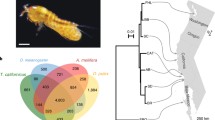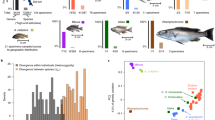Abstract
The invertebrate chordate Ciona intestinalis is a widely used model organism in biological research. Individuals from waters ranging from arctic to temperate are morphologically almost indistinguishable. However, we found significant differences in whole genomic DNA sequence between northern European and Pacific C. intestinalis. Intronic and transposon sequences often appear unrelated between these geographic origins and amino acid substitutions in protein coding sequences indicate a divergence time in excess of 20 MYA. This finding suggests the existence of two cryptic species within the present C. intestinalis species. We found five marker loci which distinguish the two genetic forms by PCR. This analysis revealed that specimens from Naples, Italy, have the Pacific-type genome, perhaps due to human-mediated marine transport of species. Despite major genomic divergence, the two forms could be hybridized in the laboratory.




Similar content being viewed by others
References
Carlton JT (1992) Introduced marine and estuarine mollusks of North America: An end-of-the-20th-century perspective. J Shellfish Res 11:489–505
Chen FC, Li WH (2001) Genomic divergences between humans and other hominoids and the effective population size of the common ancestor of humans and chimpanzees. Am J Hum Genet 68:444–56
Corbo JC, Di Gregorio A, Levine M (2001) The ascidian as a model organism in developmental and evolutionary biology. Cell 106:535–538
Coyne JA, Orr HA (2004) Speciation. Sinauer Associates, Sunderland, MA
Dehal P, Satou Y, Campbell RK, Chapman J, Degnan B, De Tomaso A, Davidson B, Di Gregorio A, Gelpke M, Goodstein DM, Harafuji N, Hastings KE, Ho I, Hotta K, Huang W, Kawashima T, Lemaire P, Martinez D, Meinertzhagen IA, Necula S, Nonaka M, Putnam N, Rash S, Saiga H, Satake M, Terry A, Yamada L, Wang HG, Awazu S, Azumi K, Boore J, Branno M, Chin-Bow S, DeSantis R, Doyle S, Francino P, Keys DN, Haga S, Hayashi H, Hino K, Imai KS, Inaba K, Kano S, Kobayashi K, Kobayashi M, Lee BI, Makabe KW, Manohar C, Matassi G, Medina M, Mochizuki Y, Mount S, Morishita T, Miura S, Nakayama A, Nishizaka S, Nomoto H, Ohta F, Oishi K, Rigoutsos I, Sano M, Sasaki A, Sasakura Y, Shoguchi E, Shin-i T, Spagnuolo A, Stainier D, Suzuki MM, Tassy O, Takatori N, Tokuoka M, Yagi K, Yoshizaki F, Wada S, Zhang C, Hyatt PD, Larimer F, Detter C, Doggett N, Glavina T, Hawkins T, Richardson P, Lucas S, Kohara Y, Levine M, Satoh N, Rokhsar DS (2002) The draft genome of Ciona intestinalis: insights into chordate and vertebrate origins. Science 298:2157–2167
Eno CN, Clark RA, Sanderson WG (eds) (1997) Non-native marine species in British waters: a review and directory. Joint Nature Conservation Committee, Peterborough, UK
Galil BS (2000) A sea under siege—Alien species in the Mediterranean. Biol Invasions 2:177–186
Gaunt MW, Miles MA (2002) An insect molecular clock dates the origin of the insects and accords with palaeontological and biogeographic landmarks. Mol Biol Evol 19:748–761
Geller JB, Walton ED, Grosholz ED, Ruiz GM (1997) Cryptic invasions of the crab Carcinus detected by molecular phylogeography. Mol Ecol 10:901–906
Hoshino Z, Nishikawa T (1985) Taxonomic studies of Ciona intestinalis (L.) and its allies. Publ Seto Mar Biol Lab 30:61–79
Kano S, Chiba S, Satoh N (2001) Genetic relatedness and variability in inbred and wild populations of the solitary ascidian Ciona intestinalis revealed by arbitrarily primed polymerase chain reaction. Mar Biotechnol (NY) 3:58–67
Kimura M (1983) The neutral theory of molecular evolution. Cambridge University Press, Cambridge
Lambert C, Lafargue F, Lambert G (1990) Preliminary note on the genetic isolation of Ciona species. Vie Milieu 40:293–295
Leveugle M, Prat K, Popovici C, Birnbaum D, Coulier F (2004) Phylogenetic analysis of Ciona intestinalis gene superfamilies supports the hypothesis of successive gene expansions. J Mol Evol 58:168–181
Linné CV (1767) Systema naturae, per regna tria naturae, secundum classes, ordines, genera, species, cum characteribus, differentiis, synonymis, locis. Holmiae, Stockholm
Satoh N (2003) The ascidian tadpole larva: comparative molecular development and genomics. Nat Rev Genet 4:285–295
Satoh N, Jeffery WR (1995) Chasing tails in ascidians: developmental insights into the origin and evolution of chordates. Trends Genet 11:354–359
Satoh N, Satou Y, Davidson B, Levine M (2003) Ciona intestinalis: an emerging model for whole-genome analyses. Trends Genet 19:376–81
Simmen MW, Bird A (2000) Sequence analysis of transposable elements in the sea squirt, Ciona intestinalis. Mol Biol Evol 17:1685–1694
Simmen MW, Leitgeb S, Clark VH, Jones SJ, Bird A (1998) Gene number in an invertebrate chordate, Ciona intestinalis. Proc Natl Acad Sci USA 95:4437–4440
Simmen MW, Leitgeb S, Charlton J, Jones SJ, Harris BR, Clark VH, Bird A (1999) Nonmethylated transposable elements and methylated genes in a chordate genome. Science 283:1164–1167
Sneli J-A, Gulliksen B (1975) Tethyum sociabile Gunnerus, 1765 (Tunicata, Ascidiacea): proposed suppression under the plenary powers. Bull Zool Nomencl 32:127–128
Stachowicz JJ, Whitlatch RB, Osman RW (1999) Species diversity and invasion resistance in a marine ecosystem. Science 286:1577–1579
Tavare S, Marshall CR, Will O, Soligo C, Martin RD (2002) Using the fossil record to estimate the age of the last common ancestor of extant primates. Nature 416:726–729
Tweedie S, Charlton J, Clark V, Bird A (1997) Methylation of genomes and genes at the invertebrate–vertebrate boundary. Mol Cell Biol 17:1469–1475
Van Name, WG (1945) The North and South American sscidians. Bull Am Mus Nat Hist 84:1–476
Acknowledgments
We thank Rosaria De Santis (Stazione Zoologica A. Dohrn, Italy), Michael Thorndyke (Kristineberg Marine Research Station, Sweden), Nori Satoh (Kyoto University, Japan), and members of Craobh Haven (Oban, Scotland) for kindly providing the animals. We are grateful to Aileen Greig for technical assistance. This work was supported by grants from the Japanese Society for the Promotion of Science to M.M.S. and by a Programme Grant from the Wellcome Trust to A.B.
Author information
Authors and Affiliations
Corresponding author
Additional information
[Reviewing Editor: Dr. Martin Kreitman]
Rights and permissions
About this article
Cite this article
Suzuki, M.M., Nishikawa, T. & Bird, A. Genomic Approaches Reveal Unexpected Genetic Divergence Within Ciona intestinalis. J Mol Evol 61, 627–635 (2005). https://doi.org/10.1007/s00239-005-0009-3
Received:
Accepted:
Published:
Issue Date:
DOI: https://doi.org/10.1007/s00239-005-0009-3




